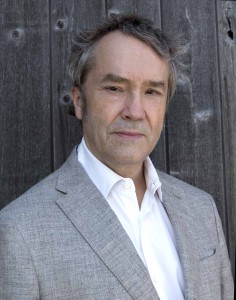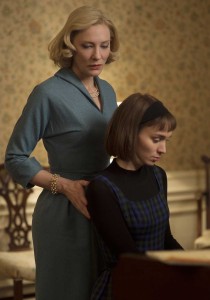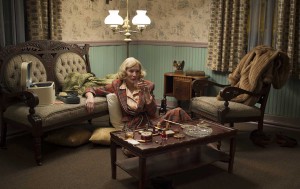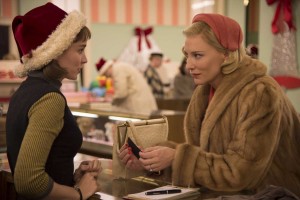
“It’s true that everyone is different and indeed everyone hears music differently,” commented composer Carter Burwell in sharing how he communicates with directors. “A piece that one director will think is melancholy, another director may think is joyful. By its nature, music is abstract and subjective, but generally speaking, the best way I find to communicate with directors is the language of drama and cinema, nothing specifically about music.”
Burwell, who regularly works with the Coen Brothers, previously composed scores for Carol director Todd Haynes‘ films, Velvet Goldmine and Mildred Pierce. On this third collaboration, Burwell describes Hayes as a visual stylist who is smart and astute about music, “I find the conversations with him to be very substantial and very helpful. That said, we don’t talk much about it until I actually send him music. Then we have something we can talk about. That’s true for most directors.”
Although Burwell gets scripts from directors that he knows before they shoot or he gets scripts to decide whether or not to do a film, he doesn’t usually write anything until there is a cut of at least some of scenes to look at. The fact that Haynes’ films are so carefully composed and thought out was very informative to Burwell for composing the music.

Both the soundtrack’s source and score compliment each other instrumentally and musically. The movie takes place post World War II, an in-between time before rock and roll took hold. Haynes and music supervisor Randall Poster sent Burwell half a dozen CDs of music from the period that they were listening to and wanted him to hear. Although the score is not specifically based upon those songs, Burwell wanted to get a feel for the music that the story’s characters would be listening to.
“The idea was to immerse ourselves in the sound of that time – what people were reacting to – because the music represents something about that culture,” explained Burwell. “There were some novelty songs. You began to hear the very first electric guitar stuff from Les Paul. Certainly jazz was intermingling with pop. Billie Holliday and a lot of jazz people were working closer to the pop domain.”
Choosing the key instrumentation for the score is mostly intuitive for Burwell. Early on he talked to the director about how the story focused on the two women and decided it would be good to keep it simple and rely on a couple of solo instruments. In the case of Carol, he selected clarinet and piano.
“Woodwinds, I thought would play well. Clarinet was my first choice because it’s capable of these dark sonorities. It’s got a feeling that fit that time. You’d hear clarinet in jazz and some of the pop tunes then and it has an urban quality. I can’t really put it into words. A clarinet seemed right. It seemed to match the color of the picture,” Burwell explained.
 Strings were also used in the score, but although one approach to a romance might be to have swelling strings playing the melody, that was not how they were used in Carol. “I don’t think we ever do that because even though the film’s a romance, it’s painfully restrained. In this case, the strings just play the rhythm almost entirely,” stated Burwell.
Strings were also used in the score, but although one approach to a romance might be to have swelling strings playing the melody, that was not how they were used in Carol. “I don’t think we ever do that because even though the film’s a romance, it’s painfully restrained. In this case, the strings just play the rhythm almost entirely,” stated Burwell.
According to the composer, “Piano is a cool instrument, capable of sounding fragile. It’s capable of a lot of different ranges of emotions. It’s a solo instrument and a percussion instrument. That seemed appropriate for the restraint that is important in this picture.”
Burwell considered the film from the point of view of falling in love and how he could “boil it down to a few steps” that he could develop into a few motifs over the course of the film. There are three main themes.
Used at the beginning and ending of the film, one theme has a pulsing heartbeat, capturing the feeling of internal excitement. Another theme that is mostly piano tackles the heightened altered state of infatuation where the rest of the world just blurs. It is heard during the abstract montage when Therese travels to Carol’s home the first time. The final theme reflects the terrible feelings of pain and loss “When your beloved is not there.”
 Burwell does not like to hear the music temp. In an effort to try and lessen the imprint of “temp love,” he tries to get music sketches to editorial as early as possible so that they can lay the original music in and play with it against the picture. He gives the music editor the option of requesting cues at different tempos.
Burwell does not like to hear the music temp. In an effort to try and lessen the imprint of “temp love,” he tries to get music sketches to editorial as early as possible so that they can lay the original music in and play with it against the picture. He gives the music editor the option of requesting cues at different tempos.
“I’m happy to let people do that, because they will anyway, whether I invite it or not. They’ll take the music and do what they want with it,” said Burwell. “So I think it’s best to get on board with that idea and at least get them playing with my music instead of someone else’s.”
Carol was an amazing canvas for a composer to work on, so Burwell had no problems coming up with ideas for the score. If anything, his issue was having too many ideas. He used Haynes as a sounding board, sending several ideas for each theme.
“Some directors don’t like being presented with lots of choices, especially with music, because although they may be valid, they can make it into a different movie, but Todd is very good with that. I love throwing a lot of things at him and using his musical intelligence to help me,” Burwell elaborated.
To keep his creative juices flowing, Burwell plays piano almost every day. If anything comes out of that process that is at all interesting, even if it has nothing to do with the current film that he is working on, he records it. Although he had no problems with the Carol score, he has catalogued 1,500 bits and pieces that he can review if he is ever blocked. “That helps me sleep at night,” said Burwell.
Burwell felt that everyone involved in every aspect of the production were working to make the same film, “It’s a case where all of the elements came together in a very special way. That does not always happen.”





